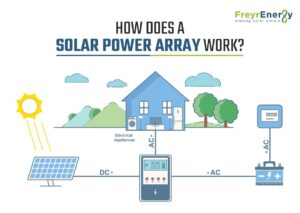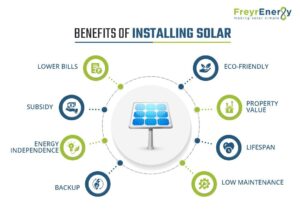What if you can reduce your electricity bills up to 90%? You aren’t the only one who finds it hard to digest the rising electricity bills. In addition, no one gives a guarantee to provide consistent electricity. There are frequent power breaks. It breaks your heart. You wonder, why on earth am I paying so much for electricity bills?
Are you looking for a solution that provides uninterrupted electricity at a lower rate? Enter the world of solar array for home.
A solar power array is a game-changer technology, providing clean and affordable power across Indian households.
Want to know more about it? Let’s go into the details to understand more about a residential solar array.
What Is a Solar Array?
It is also known as a photovoltaic array. A solar array is a group of solar panels working together. A solar panel array is much better than a single solar panel. More panels mean more power.
A residential solar array converts sunlight into electricity for your home. You can say it’s like having your own mini power station on the roof.
Key Parts of a Solar Array Setup
Let’s understand the components that go into a solar array installation.
- Solar Array Inverter: It is an essential component that converts DC electricity into AC. We cannot use DC electricity directly. It needs to be converted to AC for home use. That’s why the inverter is a crucial component for a solar array for home system.
- Solar Array Tracking System: As the Earth rotates, the sun’s direction changes. The tracking system enables the panels to track the sun’s movement and they position accordingly. It helps them to absorb maximum sunlight, resulting in more solar energy output.
- Combiner Box: It packs all panels into a single, orderly system, making the installation easy.
- Solar Array Wiring: Safely transfers the generated electricity across the setup.
- Battery Backup (Optional): Store excess energy in batteries and use it during emergencies. At night, power breakage and cloudy days.
How Does a Solar Power Array Work?

Let’s understand how a solar power array work in a step-wise manner.
- Sunlight falls on the photovoltaic cell in the solar array.
- The cells in response move, which generates an electric current.
- This electricity is in DC (Direct Current) format.
- For home use, AC (Alternating Current) is required.
- A solar array inverter converts DC electricity to AC electricity.
- Excess power is sent to the grid or stored in batteries.
- Power is sent to the grid through a net metering program, which earns you credits and lowers your electricity bills.
Solar Array Cost Analysis
Let’s analyse Solar Array Cost to help you understand what you are paying for. The following table lists the materials used in the solar array system..
Solar Array Cost Breakdown (India, 2025)
| Component / Metric | Estimated Share of Total Cost | Typical Cost Range (₹) |
| Solar Panels (Photovoltaic array) | 40–55% | ₹40,000–₹70,000 per kW |
| Inverter (string / hybrid) | 10–15% | ₹20,000–₹30,000 per kW |
| Mounting & Civil Structures | 8–12% | ₹15,000–25,000 (3 kW system) |
| Wiring, DC combiner, BOS | 5–10% | ₹10,000–20,000 (3 kW system) |
| Installation & Labour | 8–12% | ₹15,000–25,000 (3 kW system) |
| Optional Battery Backup | 15–25% | ₹50,000–90,000 (depending on storage size) |
| Total System Cost (3 kW) | 100% | ₹1.9–2.2 lakh (before subsidy); ₹1.0–1.6 lakh (after subsidy) |
Data compiled from: MNRE, CEEW, Mercom India, Bridge To India, Economic Times
Savings & ROI
| Monthly Output | 360–375 units for a 3kW solar panel array |
| Payback Period | 5–6 years |
| Lifetime Savings | Rs. 10–12 lakh over 25–30 years |
Unit Cost Comparison
|
Rs. 7 to 10 per unitRs. 2 to 3 per unit |
The government offers subsidies for residential solar array systems. It significantly reduces the solar array cost.
Solar Array Output and Efficiency
A 3kW to 5kW residential solar array generates 360 to 700 units of energy per month, if abundant sunlight is available.
High solar array output is possible by using high-quality panels and a solar array tracking system. The tracking system helps panels absorb more sunlight, resulting in more electricity production.
Why Install a Solar Array for Home?
Solar energy offers several benefits. That’s the reason many homeowners are switching to solar energy and reaping the benefits. Here are a few benefits listed below:

- Lower electricity bills
- Government subsidies
- Energy independence
- Backup during power cuts
- Zero pollution
- Higher property value
- Long lifespan (25–30 years)
- Low maintenance
Why It’s Perfect for Indian Homes
Solar energy is perfect for Indian homes due to its abundant sunlight availability in most regions. Clean energy helps combat the pollution levels in India. The government also views it as an option to meet the rising electricity demand in India. Therefore, it has offered subsidies for homeowners and tax rebates for businesses to promote solar power.
Solar energy plants are easy to install and can be set up on roof spaces as well. The rising costs of electricity from the grid, along with the need for alternative energy sources, are a pressing concern of the hour. Solar energy fills this slot, offering clean and affordable energy.
Final Thoughts
A residential solar array is more than just a power source. It’s a long-term investment plan that offers a sustainable, safe, and clean energy source. Technological innovations have made solar array installation easy.
The solar array price is affordable compared to the rising costs of the grid. In addition, Indians can benefit more from a solar array setup due to the abundance of sunlight. Who would say no to uninterrupted power supply, low electricity bills, power during emergencies and energy independence?
Do you wish to join the bandwagon? Install a solar array for home today and walk your way towards a sustainable planet.
